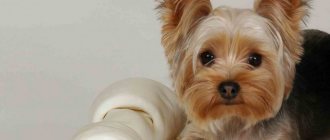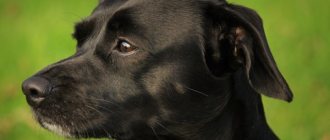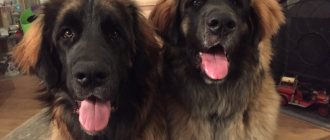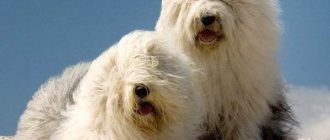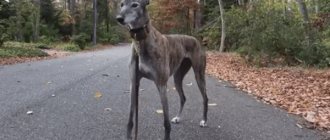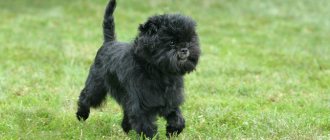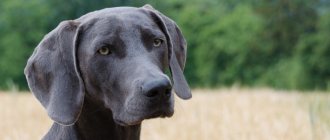The Havanese Bichon or Havanese is a small decorative dog from the group of lapdogs. She resembles an adorable plush toy, but has a perky character and an extraordinary mind. This is an ideal pet for a city apartment, for inexperienced dog breeders. He is good-natured, sociable, loyal, and easy to train. But before you get a Havanese Bichon, you need to study the description of his character. Reviews from owners and videos about these dogs will help you better understand the pros and cons of keeping them.
- Head
- Education and training
- Care
Breed traits
Breed traits (on a 5-point scale)
| Havanese Bichon (Havanese) | |||
| Activity | in the house | 3.5 | |
| on the street | 3 | ||
| Obedience | training | 2.5 | |
| strangers | 3 | ||
| Domination | in family | 4 | |
| over dogs | 3 | ||
| Defending your territory | from people | 1.5 | |
| from dogs | 3 | ||
| Sociability | in family | 4.5 | |
| with strangers | 4 | ||
| with dogs | 4 | ||
| Concentration | in family | 2.5 | |
| in front of strangers | 2 | ||
| with dogs | 3.5 | ||
| Aggressiveness | in family | 3 | |
| to strangers | 3 | ||
| to the dogs | 2 | ||
| to cats | 2 | ||
| Family behavior | calmness | 3 | |
| demand for affection | 3.5 | ||
| excitability | 2.5 | ||
| playfulness | 3.5 | ||
| excessive barking | 1.5 | ||
| behavioral breakdowns | 2.5 | ||
| Tolerance for children | up to 4 years | 4 | |
| over 4 years old | 4.5 | ||
| Institutional use | watchman | 2.5 | |
| bodyguard | 2 | ||
This breed is often compared to the following dog breeds: Maltese (Maltese Bichon), Tibetan Terrier, Bichon Frize, Shih Tzu, Labrador Retriever.
The photo shows what a Havanese Bichon looks like:
How to choose a pet
The Bichon Havanese is one of the rare image breeds. Nurseries specializing in its breeding are concentrated in Cuba and the USA. And the cost of a puppy varies between 30-90 thousand rubles.
In order not to make a mistake when choosing a Havanese Bichon, when buying a dog you need to ask:
- availability of documents;
- compliance with the breed standard;
- character traits;
- health status;
- conditions of detention.
On a note. It is not recommended to buy a Havanese Bichon puppy under three months old. It is advisable to give preference to an active and inquisitive havanese. But you should refrain from purchasing a cowardly or nervous Bichon puppy.
Description of the Havanese Bichon (Havanese) breed
The Havanese Bichon is also called the Havanese. This is a type of lapdog (Bichon) with a long, smooth coat, bred in Cuba. The breed was called Havanese, since the capital of the country is Havana. These dogs are quite rare in the world, but are the national symbol of Cuba.
Havanese dogs are very sociable, cheerful and good-natured. They are easy to train and are not prone to dominance. Therefore, they are suitable for pensioners, children, and inexperienced dog breeders. Due to their contact and sensitivity, they are used in canistherapy - they help people with neuroses, depression, panic attacks, and can be guides. In the USA, they are recommended for families with hearing-impaired and visually impaired children.
Despite their small size, Havanese dogs are used to search for termites and mold. They easily learn tricks and can perform in the circus. They show good results in dog sports: agility, freestyle, flyball. Thanks to their unpretentiousness and balanced psyche, they can be companions on trips and travels.
| Options | Characteristic |
| breed name | Havanese Bichon, Havanese |
| a country | Cuba |
| group of breeds according to the ICF classification | decorative and companion dogs, bichon section |
| life expectancy | 13-15 years old |
| height | 23-29 cm |
| weight | 3-5.5 kg |
| aggression | No |
| activity | average |
| intelligence | very smart, easy to train |
| difficulty of care | complex grooming |
pros
Havanese Bichons are decorative dogs and companions. They are people-oriented, get along well with everyone, and never show aggression even towards strangers. They are unpretentious, easily adapt to the owner’s lifestyle, and are ideal for keeping in a small apartment. These dogs have many advantages:
- have a charming appearance;
- lively facial expressions and artistic abilities;
- affectionate, loving;
- positive, cheerful, playful;
- good-natured, devoid of aggression;
- balanced, with a stable psyche;
- flexible, non-conflicting;
- very smart, easy to learn;
- love children, can be nannies;
- sensitive, understand the mood of the owner, do not impose;
- get along well with cats and other pets;
- do not require long walking;
- Wool does not smell and does not cause allergies.
Minuses
Owners of decorative dogs often pamper them; many have Bichons not as companions, but as a toy. Because of this, the pet becomes pampered and capricious. If you do not take into account the difficult care of the coat, the disadvantages of this breed are mainly associated with improper upbringing. Because of this, the Bichon Havanese may become:
- jealous;
- stubborn;
- lazy;
- playful;
- naughty;
- touchy;
- cowardly.
The video complements the description of the breed:
Video: Havanese Bichon.
Video: Havanese Bichon. Pros and cons, price, how to choose, facts, care, history
Possible diseases and methods of treating them
The Havanese Bichon is not a sickly dog, however, it is prone to diseases such as cataracts, knee and hip dysplasia. It’s easy to understand that a dog has cataracts – just pay attention to its movements. Due to poor vision, the animal will become poorly and move slowly. In addition, his pupil will become cloudy. In this case, you should consult your veterinarian.
At an advanced stage of the disease, it will not be possible to do without surgery. Fleas and worms are parasites that often plague pets, especially decorative dogs. It is important to give them tablets and capsules from them annually, if not for therapeutic purposes, then for preventive purposes.
The Havanese Bichon is one of the few breeds whose health can deteriorate due to psycho-emotional stress. Most often it is caused by the stress experienced from separation from the owner. Therefore, never leave your lap dog alone, surround it with love and care, then it will serve you for at least 15 years, as it will be healthy and cheerful.
History of the origin of the breed
Havanese Bichons are the national breed of Cuba. The lapdogs first appeared on the Canary Islands in the Middle Ages - they were brought by Spanish settlers. Bichons crossed with local dogs, with poodles. Gradually, a unique breed was formed, different from other lapdogs.
For several centuries, these miniature fluffy dogs were popular not only among the aristocracy, but also among commoners. They were called "silky Cuban dogs." They were valued not only for their attractive appearance, but also for their balanced, flexible character, activity, and fearlessness. Farmers initially even used them to kill roofs and mice. But gradually the Havanese became an ordinary decorative dog and companion.
In the 20th century, the breed was almost exterminated during the Cuban revolution. The emigrants took some of the dogs to the USA. There, at the end of the 20th century, the breed was restored and called the Havanese Bichon. In 1998, it was registered and a standard was adopted. In the 21st century, the popularity of these decorative dogs is growing, but in Russia the breed is still rare.
Appearance Standards
The Havanese Bichon has an adorable toy-like appearance. This is a small, proportionally built dog with long, silky hair. The body is strong and stocky. According to the standard, the height of a Bichon is on average 23-27 cm, and its weight can be no more than 6 kg.
Head
The head is medium in size, proportional to the body, almost square in shape. The forehead is wide, the stop is smooth. The muzzle tapers moderately, neither narrow nor blunt. Its length is equal to the length of the skull. The cheekbones are flat, the jaws are strong, with a scissor bite. The lips are thin and close fitting. The nose is well pigmented and can be black or brown.
The eyes are almond-shaped and large. The iris is dark in color. The look is smart and friendly. The ears are set high and wide, covered with long hair. They hang down and fit tightly to the head.
Frame
The physique is dense, stocky. Rectangular body. The neck is long, smoothly blending into the withers. The back is straight, slightly convex in the lower back, the croup is inclined. The chest is wide, the stomach is tucked. The tail is long and set high. The dog throws it on its back or lifts it up, folding it into a half ring. The tail is covered with long hair.
Limbs
The limbs are short, straight, set parallel. The front ones are slightly shorter than the rear ones, which affects the Bichon’s gait - it is graceful, springy, with its head held proudly. The paws are compact, with tightly knit toes.
Coat and color
Like all lap dogs, the Havanese's coat is thick and long - up to 18 cm. It forms feathers on the ears, tail, and limbs. The wool is silky and soft to the touch. The guard hair can be straight or slightly wavy, sometimes forming ringlets and curls. The undercoat is fluffy and sparse, and may be completely absent. The standard prohibits cutting or trimming the hair on the body.
The color of the Havanese Havanese can vary. While the ancestors of these dogs were mostly white, this color is now rare. The following colors are common:
- cream;
- black;
- pinkish beige;
- sable;
- chestnut;
- reddish brown;
- tobacco color;
- silver.
Any color variant may have white spots. They are usually located on the chest, limbs, and around the nose.
Photos complement the description of the appearance:
Character of Havanese dogs
These dogs become very attached to their owner and other family members. They cannot live without communication. They follow on their heels, trying to take part in all matters. They love to be the center of attention, to be praised and caressed. They try to climb higher to be closer to the person. They often climb on their knees.
They find a common language with everyone, love to play with children, and are patient with them. Due to their great sensitivity, they often adopt the habits and behavioral characteristics of their owners. Havanese dogs are not prone to dominance, are friendly to all pets, and do not enter into conflicts with other dogs. They never show aggression towards a person. They are friendly even with strangers, although they may bark.
The following features can be noted in the character of Havanez:
- friendliness;
- cheerfulness;
- curiosity;
- communication skills;
- playfulness;
- devotion;
- obedience.
One of the characteristics of Bichons is that they love to tear paper. Therefore, documents, albums and books need to be kept away from them. Left alone, the dog will definitely tear them into small pieces.
Education and training
Despite the fact that Havanese Bichons are small dogs of a decorative breed, their upbringing must be taken seriously. To avoid problems later, it is recommended to socialize the puppy and begin training it from an early age. You should immediately be introduced to the rules of behavior in the house.
The puppy must know its place, name, and feeding schedule. He must perceive the person as a leader. It is important to teach your puppy to walk on a leash. It is recommended to teach how to go to the toilet using a tray or diaper. Gradually, he will get used to relieving himself on the street, although adult Havanese often do this at home in a designated place.
These dogs are not prone to dominance, but they should not show weakness and indulge their whims. They quickly understand everything and begin to manipulate the owner. Therefore, in education you need to show persistence and consistency. All family members must maintain the same requirements.
Bichons are easy to train: they are smart and have a good memory. They quickly understand commands and can learn different tricks. Due to this feature, as well as their artistry, representatives of the breed were often used as circus dogs. They have lively facial expressions, they like to perform and be the center of attention.
The Havanese is a decorative dog and should not be trained as a service dog. He doesn't have the patience for long periods of study. There are several tips on how to make training effective:
- training should be regular;
- Lesson duration no more than 5 minutes;
- It is better to conduct them in a playful way;
- You should not repeat one command more than 3 times, the Bichon will get bored with it;
- you cannot be rude or use physical punishment;
- More often you need to praise and caress your pet, give him treats for each correctly performed action.
Education and training
Since the lapdog is a sociable and friendly dog, difficulties with its training arise extremely rarely. She always strives to receive praise and approval from her owner, so she behaves accordingly.
Important! An educational strategy should be chosen, first of all, based on the purpose of your four-legged friend. When dealing with a Cuban lapdog, you should be gentle, patient and affectionate.
We advise you to first teach your dog to defecate outside, he should not do it in the house! Take him to the yard and wait for him to mark the territories. At this point, praise him profusely so that he understands that he did the right thing. You should also show him a place of rest, preferably one that is personal to him.
Pet stores sell excellent, comfortable beds for small indoor dogs. We recommend purchasing one. You can also teach your lapdog easy and even complex commands, but it is important to be able to keep her attention. Toy dogs are rarely trained as service dogs, as they are considered difficult to train.
But no, they are just overly playful, sometimes this quality gets in the way. But, if you learn to “turn on” your pet’s attention and be able to keep it on you, success is guaranteed. The simplest way is to snap your fingers loudly and invite him to follow the command, after which you give him a treat or scratch him behind the ear.
Features of maintenance and care
The Havanese is an ideal dog for apartment living, for homebodies. She does not require much physical activity; it is enough to walk her twice a day for half an hour. An adult dog can be taught to use a litter tray or diaper to go to the toilet. In the cold season, it is better to take your pet outside in clothes - due to the lack of a thick undercoat, Bichons quickly freeze.
Care
The Havanese's coat does not shed much, but it must be brushed several times a week, otherwise tangles will quickly form. Grooming Havanese dogs is not recommended, especially if they are being shown. It is only allowed to shorten the hair on the face and paws to make it easier to maintain cleanliness. The hair above the eyes is collected in a ponytail. But owners of pet dogs that don't show often give them haircuts. This is convenient, especially in summer.
It is not worth bathing your pet often - they are clean, their fur does not smell. It is necessary to use special shampoos for long-haired dogs. If the Bichon is white, you will also need a special whitening powder - these dogs often have lacrimation and the fur under the eyes turns red.
Other hygiene procedures are simple:
- Wash your paws and belly after every walk;
- after eating, wipe your face;
- trim claws once a month;
- wash your eyes with chamomile decoction or tea leaves;
- examine and clean your ears every week; it is necessary to pluck out the hairs inside the auricle, otherwise they can cause inflammation;
- Brush your teeth several times a week or give chewy treats more often.
The photo shows Havanese dogs with different haircuts and hairstyles:
Nutrition
You can feed the Havanese with both dry food and natural food. You just need to monitor the calorie content and quantity - they are prone to weight gain. An adult pet is fed 2 times a day. The serving size is calculated based on the dog’s weight: 20 g per kilogram.
Dry food must be at least super-premium class. You need to choose those that are designed for small breeds with long hair. The composition must contain at least 35% meat, additional vitamins and minerals.
With natural feeding, the pet’s diet includes lean meat, offal, sea fish, vegetables, and dairy products. It is not necessary to add porridge, since bichons eat little, are not very active, and there is no need to increase the calorie content. Carbohydrates in the daily diet should be no more than 30-40%. With this method of feeding, it is necessary to add vitamin and mineral supplements to the food.
Health
Bichons are long-lived dogs. On average they live 13-14 years, but with good care they can live up to 16 years or even longer. Their health is quite good, but sometimes the following diseases occur:
- joint dysplasia;
- cataract, retinal detachment;
- otitis;
- indigestion;
- chondroysplasia;
- dislocation of the kneecap;
- Perthes disease;
- cardiovascular pathologies.
Possible diseases
Breeders have two opinions regarding the health of these four-legged dogs. Some believe that the breed is characterized by good health and disease-resistant immunity, and the gene pool guarantees the absence of many hereditary diseases. Others are convinced that the Havanese Bichon is not a very disease-resistant breed.
Havanese Bichon runs to his owner
However, both of them agree on one thing - there are not so many diseases specific to this breed. These include eye diseases, ear diseases, diseases of the musculoskeletal system, kidney failure, and deafness.
As for eye diseases, the most common are cataracts and retinal detachment. If the disease is not noticed in time and drug treatment is not started, the dog may lose its vision. In the initial stages, drug treatment is also suitable, but only after consultation with a veterinarian.
Skeletal-related diseases include elbow dislocation and hip dysplasia. However, dysplasia is treatable and if you get rid of it in time, then great harm can easily be avoided.
Prevention of diseases of the musculoskeletal system will be a healthy lifestyle - properly organized nutrition and feasible physical activity. Moreover, it is simply necessary to physically load this animal.
The Havanese Bichon is suitable for keeping in an apartment.
In addition, the owner of a Havanese Bichon should take note of ear diseases that are associated with the dog’s anatomy. They often become inflamed, and advanced cases lead to deafness. In any case, it is better not to self-medicate, but to go to a veterinary clinic.
How to buy a Havanese puppy
To buy a purebred Havanese, you need to contact a nursery. This breed is not very common in Russia, but a responsible breeder can be found. The average price of a puppy is 30-70 thousand rubles. If a dog is offered cheaper, it may be a mixed breed or an animal with genetic pathologies.
When choosing a puppy, you need to pay attention not only to the presence of all the necessary documents. It is important to study the living conditions of animals, compliance with standards, behavior and health of babies.
A healthy Havanese puppy should be playful and curious. He has a moist, well-pigmented nose, a soft shiny coat without bald spots or dandruff, and his eyes are not bulging and have no discharge.
The photographs show what the puppies should look like:
The video complements the characteristics of the breed:
Video: Havanese Bichon
Havanese Bichons are decorative dogs. They are person-oriented and need constant contact with him. They are easy to train, loyal and obedient. But you should not get this lapdog for those who are often not at home or who are not ready to devote a lot of time to their pet. When alone, the Bichon will become very sad and may start acting out and ruining things. But in response to affection and attention, he will give his love and brighten up loneliness.
Choosing a puppy
Havanese dogs are most popular in the United States; most nurseries for breeding them are located there. In our country, this breed is rare, but nevertheless, puppies can be found. You should only purchase a baby from a trusted breeder with a good reputation and positive reviews.
Havanese puppies are difficult, but can be found.
It is very difficult to distinguish a small Havanese from other adjacent breeds or just a similar outbred animal, since the puppies of all lapdogs are very similar. Only supporting documents (parental pedigrees, puppy records, etc.) can serve as a guarantee of purebredness.
It is better to avoid buying a cute Havanese dog at a bird market or in a subway passage at a very attractive price, since purebred puppies of this rare breed are not sold that way.
Price of a puppy of this breed
The cost of Havanese babies ranges from 20-40 thousand rubles, it all depends on the birth and title of the parent couple, as well as on the prospects of the upcoming exhibition activities. For show class puppies they ask for more (up to 70 thousand). A pet without documents can be found for 8–10 thousand rubles.
